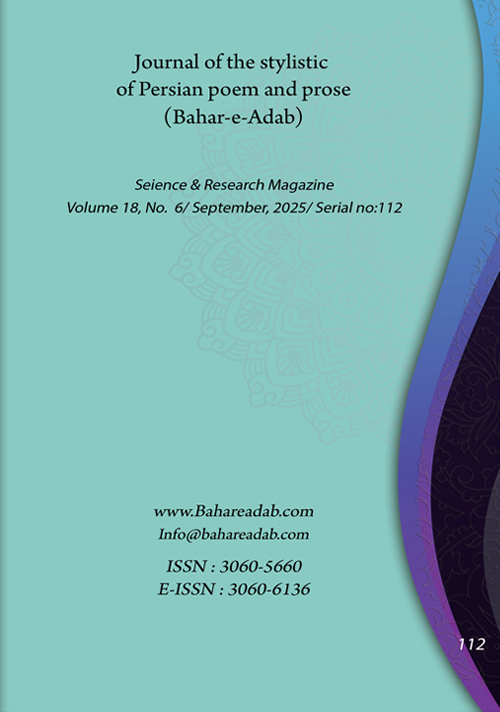- Count View : 4
- آدرس کوتاه شده مقاله: https://bahareadab.com/article_id/1865
- کد doi مقاله: Doi: 10.22034/bahareadab.2025 .18 .7901
Journal of the stylistic of Persian poem and prose
volume Number 18،
number In Volume 6،
،
issue Number 112
The fourth paradise from the history of the eight paradises by Idris Badlisi from the perspective of literary stylistics
Zinat Sadat Hosseini , Seyedeh Roqiyeh Alavi (Author in Charge), Mehri Pakzad
Abstract
BACKGROUND AND OBJECTIVES: The first story written in Persian in the Ottoman Empire is called Eight Paradise, which Badlisi dedicated to the lives of eight kings of the Ottoman dynasty. This article checked the fourth paradise from this work to determine the style Badlisi followed in writing the History of the Eight Paradises and the extent to which he adhered to the style of the time or innovated.
METHODOLOGY: This article checked the Fourth Paradise from the Eight Paradises in a descriptive-analytical manner from the perspective of stylistics on three levels: linguistic, literary and intellectual, presenting it in its entirety. The content and information are unadulterated and new in every respect, as the Fourth Paradise has been preserved in manuscript form to this day and no corrections have been made to it.
FINDINGS: The Fourth Paradise is dedicated to the era of Sultan Yıldırım Bayezid. Badlisi did not name his sources and documents and called each paradise an inscription. The fourth inscription contains sixteen stories. In fact, the life and deeds of Yıldırım Bayazid are narrated in sixteen parts, and Badlisi calls each of these parts a story. The prose of the Eight Paradises and consequently the Fourth Behesht is difficult, technical and artificial prose. The boring and coherent prose makes it difficult to understand the text. The predominant devices in this work are: alliteration, allusion, ensuring poetry in prose, simile and metaphor. Badlisi usually praises the king"s deeds or attributes them to the influence of fate or the minister"s influence on the king, and sometimes he remains silent.
CONCLUSION: The Fourth Paradise as a historical source narrates a report from the era of Yıldırım Bayazid. Compared to the three previous Paradises, the artificial and elaborate prose of Idris is still solid and unified and decorated with verses, order, Persian and Arabic poetry and abandoned Arabic words.
Keyword
Badlisi
, Eight Paradises
, Fourth Paradise
, style.
- The Holy Quran.
- Badlisi, Idris. Original copy. Sulaymaniyah Library Archives, Türkiye, No. 2197. Asad Effendi Books Section.
- Badlisi, Idris. Draft copy, copy available in the Noor Osmaniyya Library under number 3209 and new registration number 2742/3.
- Badlisi, Idris. Standard copy. Available in the London Library under number 1655, which is written in large letters as the treasury copy.
- Badlisi, Mir Sharaf al-Din Khan. (2006). Sharafnameh, translated by Professor Hejar into Kurdish. Third edition. Erbil: Aras, p. 556.
- Bahar, Malek al-Shu'ara. (2001). Stylistics. With the efforts of Dr. Seyyed Abu Taleb Mir-Abedini. Tehran: Toos, pp. 431-510.
- Bahar, Malek al-Shu'ara. (1994). Stylistics. Three volumes. Second edition. Tehran: Amir Kabir, p. 103.
- Binesh, Taqi. (2007). Article on the Method of Correction of Persian Texts. Collection of Articles on the Method of Correction. Edited by Mohammad Nazari. Tehran: Central Library and Documentation Center of the University of Tehran, p. 114.
- Pakzad, & Mehri. (2010). Idris Badlisi, Hasht Behesht and his other works. Journal of Epic Literature, 10(6), 68-94.
- Pakzad, Mehri. (2011). Understanding Hasht-Behesht by Idris Badlisi. Persian Literature, Mashhad Azad University. Vol. 29, pp. 156-189.
- Pakzad Mehri. "Elements of Iranian Culture in the Eight Paradises of Idris Badlisi." (2013): 149-176.
- Pakzad, Mehri. (2019). Badlisi and his history on the occasion of the correction and publication of the history of Hasht Behesht. The growth of history education. No. 71, pp. 66-62.
- Husseini, Fathi bin Abdul Qadir. (2009). Encyclopedia of the Genealogy of the Prophet's Family. Jordan: Al-Dar Al-Arabiya L'Msamu'at, p. 484.
- Dehkhoda, Ali Akbar. (2007). Dictionary. Tehran: Dictionary Institute, pp. 585-610.
- Zelai, Negar. (2004). Takfur. Encyclopedia of the Islamic World. Vol. 8. Tehran: Islamic Encyclopedia Foundation, p. 189.
- Rastegar Fasaei, Mansour. (2001). Types of Persian Prose. Tehran: Samt, pp. 501-510.
- Razavi, Seyyed Abolfazl and Maleki Monfared, Hossein. (2018). “Analysis of Badlisi Historiography with Emphasis on the Fourth Book”. Scientific-Research Quarterly of Islamic History. Volume 19. Issue 2. Serial Issue 74, pp. 136-101.
- Seyed Hosseinzadeh, Hoda. (2016). The Common Cultural Heritage of the Agh-Quyunlu and the Ottomans; Idris Badlisi. Asia Minor Studies. Vol. 1, 163-182.
- Shamisa, Sirous. (1998). Prose Stylistics. Second edition. Tehran: Mitra, p. 168.
- Safa, Zabihullah. (1989). A Brief History of the Development of Persian Poetry and Prose. Tehran: Qoqnos, p. 89.
- Ali Mohammadi, Nematullah. (2010). A content study of the eight paradises of Badli in comparison with the three main sources of the Juwayni explorer. Tarikh Wassaf and Zafarnameh of Ali Yazdi. Nameh Tarikh-e-Pajuhan. No. 22, pp. 136-171.
- Qazvini Haeri, Yasser. (2010). The Discourse of Legitimacy in the Eight Paradises of Idris Badlisi. Studies in the History of Islam. No. 5, pp. 107-128.
- Mayel-Haravi, Najib. (1980). Criticism and correction of texts, stages of manuscript study and methods of correcting Persian manuscripts, Mashhad: Astan Quds Razavi Islamic Research Foundation. P. 167.

